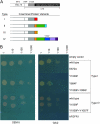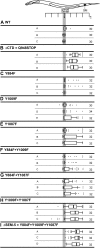Caenorhabditis elegans fibroblast growth factor receptor signaling can occur independently of the multi-substrate adaptor FRS2
- PMID: 20308281
- PMCID: PMC2881135
- DOI: 10.1534/genetics.109.113373
Caenorhabditis elegans fibroblast growth factor receptor signaling can occur independently of the multi-substrate adaptor FRS2
Abstract
The components of receptor tyrosine kinase signaling complexes help to define the specificity of the effects of their activation. The Caenorhabditis elegans fibroblast growth factor receptor (FGFR), EGL-15, regulates a number of processes, including sex myoblast (SM) migration guidance and fluid homeostasis, both of which require a Grb2/Sos/Ras cassette of signaling components. Here we show that SEM-5/Grb2 can bind directly to EGL-15 to mediate SM chemoattraction. A yeast two-hybrid screen identified SEM-5 as able to interact with the carboxy-terminal domain (CTD) of EGL-15, a domain that is specifically required for SM chemoattraction. This interaction requires the SEM-5 SH2-binding motifs present in the CTD (Y(1009) and Y(1087)), and these sites are required for the CTD role of EGL-15 in SM chemoattraction. SEM-5, but not the SEM-5 binding sites located in the CTD, is required for the fluid homeostasis function of EGL-15, indicating that SEM-5 can link to EGL-15 through an alternative mechanism. The multi-substrate adaptor protein FRS2 serves to link vertebrate FGFRs to Grb2. In C. elegans, an FRS2-like gene, rog-1, functions upstream of a Ras/MAPK pathway for oocyte maturation but is not required for EGL-15 function. Thus, unlike the vertebrate FGFRs, which require the multi-substrate adaptor FRS2 to recruit Grb2, EGL-15 can recruit SEM-5/Grb2 directly.
Figures




Similar articles
-
The Caenorhabditis elegans protein SOC-3 permits an alternative mode of signal transduction by the EGL-15 FGF receptor.Dev Biol. 2024 Dec;516:183-195. doi: 10.1016/j.ydbio.2024.08.014. Epub 2024 Aug 21. Dev Biol. 2024. PMID: 39173814
-
FRS2 proteins recruit intracellular signaling pathways by binding to diverse targets on fibroblast growth factor and nerve growth factor receptors.Mol Cell Biol. 2000 Feb;20(3):979-89. doi: 10.1128/MCB.20.3.979-989.2000. Mol Cell Biol. 2000. PMID: 10629055 Free PMC article.
-
The Caenorhabditis elegans EGL-15 signaling pathway implicates a DOS-like multisubstrate adaptor protein in fibroblast growth factor signal transduction.Mol Cell Biol. 2001 Dec;21(23):8104-16. doi: 10.1128/MCB.21.23.8104-8116.2001. Mol Cell Biol. 2001. PMID: 11689700 Free PMC article.
-
The GRB2/Sem-5 adaptor protein.FEBS Lett. 1994 Jan 31;338(2):113-7. doi: 10.1016/0014-5793(94)80346-3. FEBS Lett. 1994. PMID: 8307166 Review.
-
Regulation of growth factor signaling by FRS2 family docking/scaffold adaptor proteins.Cancer Sci. 2008 Jul;99(7):1319-25. doi: 10.1111/j.1349-7006.2008.00840.x. Epub 2008 Apr 29. Cancer Sci. 2008. PMID: 18452557 Free PMC article. Review.
Cited by
-
Knockdown of the C. elegans kinome identifies kinases required for normal protein homeostasis, mitochondrial network structure, and sarcomere structure in muscle.Cell Commun Signal. 2013 Sep 23;11:71. doi: 10.1186/1478-811X-11-71. Cell Commun Signal. 2013. PMID: 24060339 Free PMC article.
-
Invading, Leading and Navigating Cells in Caenorhabditis elegans: Insights into Cell Movement in Vivo.Genetics. 2018 Jan;208(1):53-78. doi: 10.1534/genetics.117.300082. Genetics. 2018. PMID: 29301948 Free PMC article. Review.
-
What lies beneath: Hydra provides cnidarian perspectives into the evolution of FGFR docking proteins.Dev Genes Evol. 2020 May;230(3):227-238. doi: 10.1007/s00427-020-00659-4. Epub 2020 Mar 20. Dev Genes Evol. 2020. PMID: 32198667 Free PMC article.
-
Schistosoma mansoni Fibroblast Growth Factor Receptor A Orchestrates Multiple Functions in Schistosome Biology and in the Host-Parasite Interplay.Front Immunol. 2022 Jun 22;13:868077. doi: 10.3389/fimmu.2022.868077. eCollection 2022. Front Immunol. 2022. PMID: 35812433 Free PMC article.
-
FGFs: Neurodevelopment's Jack-of-all-Trades - How Do They Do it?Front Neurosci. 2011 Dec 5;5:133. doi: 10.3389/fnins.2011.00133. eCollection 2011. Front Neurosci. 2011. PMID: 22164131 Free PMC article.
References
-
- Bennett, D. C., 2009. Identifying interactors of C. elegans FGFR signaling. Ph.D. Thesis, Yale University, New Haven, CT.
-
- Borland, C. Z., J. L. Schutzman and M. J. Stern, 2001. Fibroblast growth factor signaling in Caenorhabditis elegans. Bioessays 23 1120–1130. - PubMed
-
- Branda, C. S., 2001. Mechanisms of sex myoblast migration in C. elegans hermaphrodites. Ph.D. Thesis, Yale University, New Haven, CT.
-
- Branda, C. S., and M. J. Stern, 2000. Mechanisms controlling sex myoblast migration in Caenorhabditis elegans hermaphrodites. Dev. Biol. 226 137–151. - PubMed
Publication types
MeSH terms
Substances
Grants and funding
LinkOut - more resources
Full Text Sources
Research Materials
Miscellaneous

